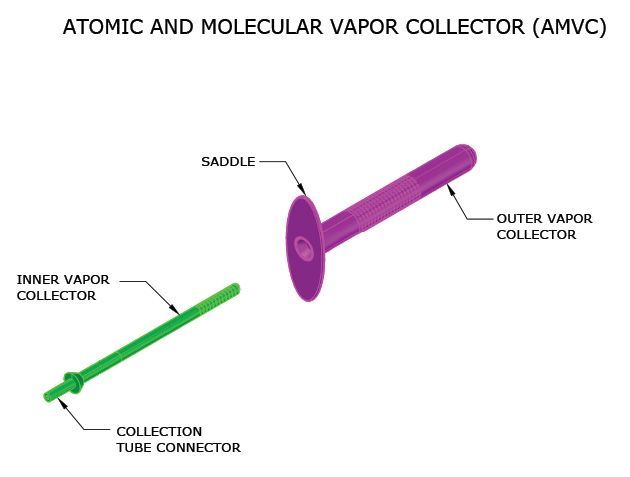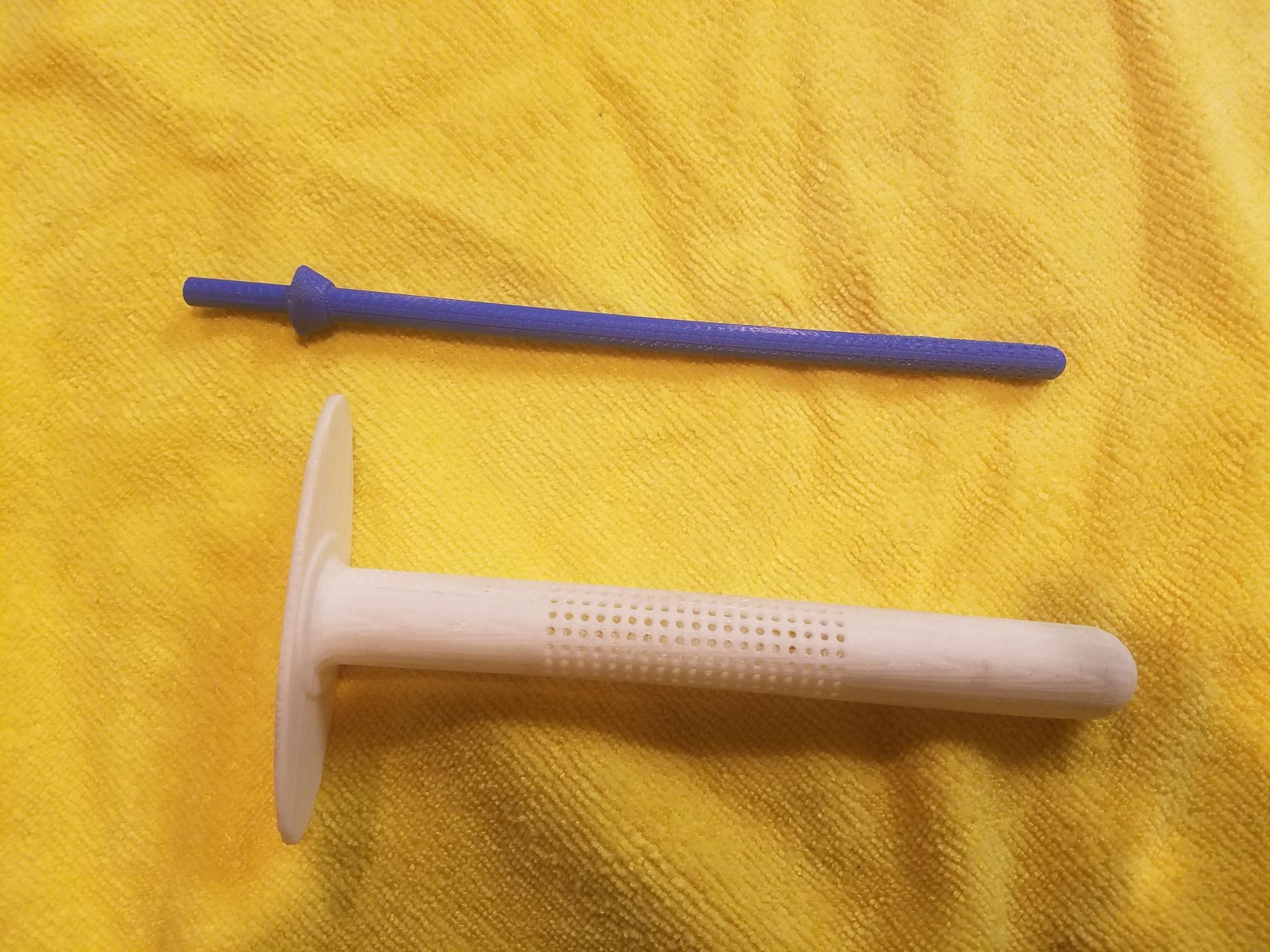AMVC
A patent-pending device and a method for capturing atomic elements and molecular compounds in air, water, or solids. The applications it encompasses are limitless.

The vapor collector is comprised of simple components, all fabricated in to one piece. Its major design features include an Outer Vapor Collector, which is a hollow tube with perforations of various sizes toward the bottom. Its purpose is to sample atomic and molecular vapors, while capturing detritus, like dust, leaves, rain, secretions, body fluids, and the like. The second major feature of vapor device is the Inner Vapor Collector. It, too, is a hollow tube, but with perforations of various sizes at the top. Its purpose is to capture the air sample with out any associated detritus. Finally, a connector at the base of the Inner Vapor Collector allows for the attachment of a sampling or vacuum line. This vacuum line is typically the air sampling line which leads to an appropriate analytic device, like a mass spectrometer or GCMS, for example, to quantify and qualify the vapors collected.


The AMVC™ vapor collector can be constructed of rigid, flexible, disposable, sterile, and/or reusable materials of various lengths, as long as the materials do not interfere, contaminate, interact, or compromise the air being sampled.
Applications for the collector are limitless. Generally, the vapor collector is essential for medical, pharmaceutical, environmental, atmospheric, energy, aerospace, drug enforcement, automotive, explosive detection, geological, forensic, agricultural, scientific, research, and veterinary applications. Where ever atomic or molecular vapors sampled need an uncontaminated source of uncondensed air for testing, monitoring, diagnosing, analyzing, or evaluating the quality of air in any sampled source, the AMVC™ is critical.
In medical, veterinary, and pharmaceutical applications, the collector captures molecular and atomic compounds emanating from different body cavities (stomach, lungs, rectal, nasal, vaginal, bladder, etc.) in humans and in animals for identification and quantification in various analytic devices. As such, it can be used as an adjunct to, or a replacement for, other conventional tests (i.e., blood, tissue samples, surgeries, biopsies, etc.), which take time to analyze, are expensive, and have invasive consequences, like iatrogenic and nosocomial infections. With the vapor collector, real-time, immediate results are obtained when connected to appropriate mass spectrometers, or other analytic devices. In the energy, geological, aerospace, and environmental arenas, the vapor device collects volatile organic/inorganic chemicals and atomic elements to detect water, air, and solid contaminants, such as lead in city water supplies. In the drug detection area, the vapor collector helps determine the presence of illicit substances in shipping containers or semi-trucks. In explosive detection, the air sampled by collector facilitates the detection of various explosive compounds at airports, stadium events, and other mass gatherings. In the agricultural industry, the vapor collector helps identify the presence of spoilage and pathogens to food supplies in warehouses, shipping containers, store shelves, and the like. Additionally, the presence and concentrations of pesticides, herbicides, and fertilizers in farm fields can be sampled with the vapor collector.
A specialized application of the vapor collector includes the nascent field of breath research for cancer detection, metabolic disorders, and other infections in humans. In these applications, patients exhale into the vapor collector which is attached to a collection tube, which is connected to and analyzed by various analytic devices. This may initially obviate the need in some instances for more invasive medical procedures. As such, it can be used for immediate medical screening for infectious diseases, metabolic disorders, physiological health, heavy metal contamination, and cancers. Also, the vapor collector can replace the need for more invasive procedures, like colonoscopies, bronchoscopies, endoscopies, catheterizations, etc. The device can also be attached to any sampling line which is connected to a mass spectrometer or other analytic devices for environmental, agricultural, explosive detections, drug identification, geological, forensic, atmospheric, etc. air sampling uses. The rigid version of the AMVC™ can be mounted on rail, aircraft, ships, and other Envirolytics® mobile platforms. A heat exchanging device (the AHE™), also created by Envirolytics®, is an essential adjunct to the vapor collector.
The AMVC™ can be cleared of detritus after insertion in the body cavity through positive air flow in the Collection Tube Connector. Additionally, radioactive isotopes, luminescents, dyes, stains, enzymes, and other effluents can be introduced into the selected body cavities through the Collection Tube Connector to enhance the identification and analysis of atomic and molecular vapors under investigation through the use of mass spectrometers and other analytic technics.
Applications for the AMVC™ are endless, especially when coupled to Envirolytics® heat exchanging device (AHE™), which may be attached to appropriate air sampling instrumentation inside one of Envirolytics'® mobile platforms, like the SciArk® or SciLab®.
